Ideas for Horse Fencing Options
By Chris Churchill, Five Star Ranch Staff Writer
Horse fencing options are as varied as horse breeds. From the traditional wood rail fences, electric hot wire to the high tech plastic fences all types of farm fence have their advantages and disadvantages. In this article we look at a variety of fences from a horse owner’s perspective. Here’s a list of the common horse fencing options.
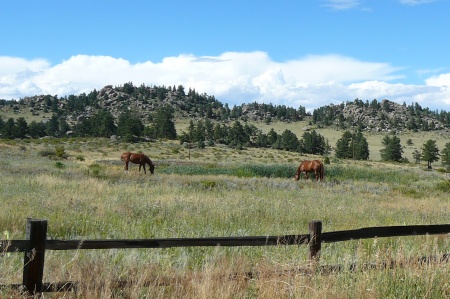
- Wood Rail Horse Fence – Wood Board Fence
Wooden rail fence is a popular variety of horse fence. It is attractive, traditional and relatively inexpensive.
The downside to a wood fence is that it requires maintenance upkeep to keep it looking good. If its painted, it requires regular painting. Horses can and will break boards and can run through a wood fence if spooked. The nails from the board can also become a hazard if they come loose and a horse accidentally steps on it. Many horse owners use a strand of hot wire on the top rail to discourage pushing on the wood or chewing on it.
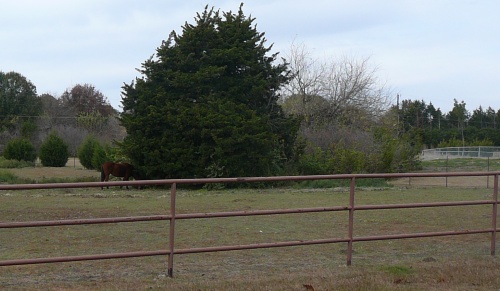
- Pipe Fence for Horses
Pipe fencing has become very popular horse fence in many parts of the country. It is attractive and highly visible. It is expensive to install, but once up there is little maintenance and it lasts a long time. Its also very solid, so there is little give if a horse were to run into it. That said, I’ve seen it used on many breeding farms and owners tell me that due to the high visibility, most horses don’t run into it very often.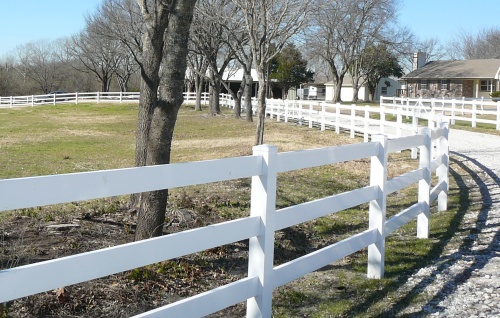
- Vinyl or PVC fence
If you’re looking for a fast way to improve the look of your farm, few fences have the crispness as vinyl or plastic fence. It can add street appeal and increase the value of your property.
Other advantages of vinyl fence is that it is highly visible and visually attractive. It comes in a variety of colors and styles.
A huge reason for its popularity is that maintenance of vinyl fence is almost non-existent. There’s no painting required and horses don’t chew it so there’s no replacing cribbed boards.
Okay, so what are the downsides of using vinyl fence? Well, the first obvious negative is that vinyl fence is expensive. However, there is a bigger negative you need to know about if you’re considering vinyl fence to contain horses. The problem with using vinyl fence as horse fence is that the rails can “pop” out if horses push on them, so by themselves the plastic fences don’t hold horses well.
I’ll never forget how I met one of my new horse neighbors a few years ago. I was driving home at dusk and encountered two lovely horses standing in the middle of the road. There was no road shoulder to speak of, so I stopped my car in the middle of the road and put on my flashers. I pulled off my belt and walked up to one of the horses who was friendly and sweet. I slipped my belt around his neck and led the horse to the house. Being a herd animal, the second horse obediently followed his buddy.
The owner had just moved in and the horses were in the pasture for the first time. The owner had selected the fence thinking it was a safe alternative to wire fence. Her horses had apparently “tested” the fence by pushing on the rails and had knocked several loose. What was scary was that the owner didn’t even know the horses were loose and had no idea of that the fence rails could pop out so easily.
The story has a happy ending. No horses were hurt and I became fast friends with the new horse neighbor. The next morning she strung electric hot wire fence around the top of her pretty vinyl fencing to act as a deterrent to pushy horses. The hot wire in conjunction with the vinyl fence worked quite well.
The take away lesson: If you have vinyl fence with horses, run a strand of hot wire on the inside of the top rail if you’re planning on running horses in a pasture using vinyl fence. This is actually a nice combination. The vinyl fence provides high visibility and looks and the hot wire discourages horses from pushing or leaning on the boards, thus decreasing the chances that they will pop the boards out.
The other option is to use the vinyl fence in areas where you have redundant fencing so your horses are still contained if they happen to pop some boards out.
- Electric Horse Fence – Electric Tape or Hot Wire Fence
Hot wire fence is normally used as temporary fencing. I confess I once used hot wire as temporary fence for nearly ten years in my back pasture with only an occasional escapee. At the time I lived out in the country so far I couldn’t see a neighbor and my property was in a dead end mountain cove with no traffic.
I would never recommend using electrics fence by itself in a congested area or if you live near a busy road. however, if you are needing some temporary cross fencing – which is an ideal use of electric fence – you’ll discover pretty quick that its easy to install and very inexpensive.
To increase visibility, I’d recommend using one that is at least 2 inches wide. Plan on checking it regularly as it will come down. Where I lived deer regularly knocked it down and one of my fears was that my horses would get tangled in the downed tape. They didn’t but the chance was there so I always worried.
Electric fence is perfect to help you keep horses out of part of your pasture while you rotate it or seed part of it.Use caution using it as a sole perimeter fence due to low visibility. It works better if used in conjunction with another type of fence such as wood rail or vinyl fence. If you do use electric wire fencing, use flagging tape with it to improve visibility.
If you want electric fence, but don’t have electricity nearby, there are solar electric fence chargers that work fairly well.
- Wire Mesh Horse Fence or Woven Field Fencing
There are many types of wire mesh fence that you can use to fence your farm. Wire fence is relatively inexpensive and probably the most forgiving fence if a horse runs into it.
The one thing you need to be careful with wire mesh fence is the size of the mesh openings. Make sure the mesh size you use is small enough to keep hooves out – including small foal hooves if you raise horses.
Wire mesh fence isn’t as visible as some types of fence, so many horse owners use flagging tape or a wood top rail to improve visibility. If you live in an area where vines are prevalent, wire mesh fence can turn into a headache. Vines love to grow on wire mesh and it is difficult to remove the vines once they are established in your fence.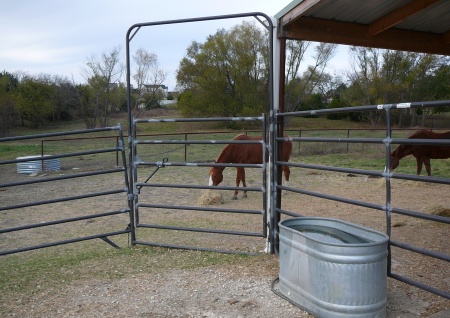
- Tubular Panels as Portable Horse Fence
If you’ve visited your local feed store, you have probably seen the tubular steel round pens on display.
Great for fencing around barns or as paddocks. Many horse owners use the panels as fencing around the barn. They are easy to install and move around so they provide a lot of flexibility to the horse owner.I have a round pen next to my barn. Several times I have needed to isolate a horse due to injury. I didn’t want to stall the horse the whole time, but I wanted its activity restricted. Since it couldn’t move quickly, I didn’t want the injured horse with the herd. My solution was to drag the round pen panels over to my end stall thereby creating a temporary convalescence paddock. I wouldn’t have been able to do that with permanent fencing.
- Braided Wire Cable Horse Fence
Braided wire is durable, low maintenance, and highly visibly horse fence. A couple of downsides are that horses will rub on it – I once had a beautiful buckskin rub out a section of her black mane on a braided wire fence. Apparently it felt good scratching on it.
Braided wire cable can be stretched if your horse pushes on it a lot. You may need to tighten it from time to time or add a hot wire to the top.Braided wire fence is heavy and needs sturdy posts. For this reason it is often used with steel pipe fencing.
- Rubber Fence
The obvious positive on rubber belt fencing is that it gives if a horse runs into it. The problem with it is that it stretches so you will need to tighten the fence periodically to keep it snug.
- Buck and Rail Fence
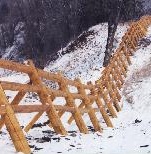
- If you live in a rocky mountainous area you are probably familiar with buck and rail fence. This type of fencing is popular in rocky areas because installation doesn’t involve digging holes.Buck and rail fences are often called wildlife friendly fences as they don’t have wire that wildlife can get tangled in.A buck and rail fence is a triangular shaped section with rails connecting the two triangular ends. It is attractive fence and in the right places it is very practical fencing.
- Chain Link
Although I’ve seen chain link fence used to contain horses, it is not a common fence for horses due to cost. However, if you keep stallions or have horses in a crowded area and you do not want them getting loose, chain link may be a solution for you. Plan on using a hot wire on the top rail as horses will lean on the chain link and stretch it out.
- Combination horse fence
Many farms and ranches use a variety of horse fence types depending on where the fence is and its purpose. If you are thinking of installing new horse fence, please take a moment to read through our article on horse fencing safety and fence layout guidelines. It offers some practical horse sense guidance on fence layout that can save you vet trips and make your life easier.
Horse Fence Books
Below are some great books to help you build your horse fence.